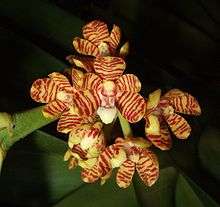Acampe rigida
Acampe rigida is a species of orchid native to the forests of tropical southern Asia where it grows on trees and rocks at altitudes of up to 1,800 m (6,000 ft).
| Acampe rigida | |
|---|---|
 | |
| Scientific classification | |
| Kingdom: | Plantae |
| Clade: | Tracheophytes |
| Clade: | Angiosperms |
| Clade: | Monocots |
| Order: | Asparagales |
| Family: | Orchidaceae |
| Subfamily: | Epidendroideae |
| Genus: | Acampe |
| Species: | A. rigida |
| Binomial name | |
| Acampe rigida | |
| Synonyms[1] | |
|
List
| |
Description
Acampe rigida is a robust species with an unbranched stem up to 1 m (40 in) in length and 20 mm (0.8 in) in diameter. The leaves are disticious. The stem nodes are about 25 mm (1 in) apart and each bears a somewhat fleshy, upright leaf with sheathing base. The apices of the leaves are obtuse and unequally bilobed. The inflorescence is unbranched or sparsely branched, with many slightly fragrant, upturned, cup-shaped flowers less than 25 mm (1 in) in diameter. The petals are fleshy, and are yellow with purplish-brown stripes; they have a thick, white, three-lobed lower lip, and a short spur. They are followed by cylindrical or fusiform capsules.[2]
Distribution and habitat
Acampe rigida is native to the Andaman Islands, Assam, Bangladesh, Bhutan, Cambodia, China, India, Laos, Malaya, Myanmar, Nepal, the Philippines, Sri Lanka, Thailand and Vietnam.[1][2] It occurs in forests, either growing epiphytically on the branches and trunks of trees, or growing on rocks, and often forming dense clumps. Its altitudinal range is from 300 to 1,800 m (1,000 to 6,000 ft).[2]
Ecology
Acampe rigida is a deceptive orchid in that it produces a fragrance that may attract insects but does not then offer them any reward. It is self-compatible, but has not evolved any particular mechanism to enable self-pollination. In Guangxi province in southwestern China, it flowers in late August and September, at a time of year when rain falls almost daily and insect pollinators are scarce. In a research study, after many hours of observation, a single insect was observed to visit a flower, but pollination did not occur. Instead, the plant exhibited ombrophily; rain drops falling on the tips of the stamens knocked the caps off the anthers, and further drops caused the pollinia to be ejected upwards, after which strap-like stipes arrested their movement and caused them to land in the stigma cavity, resulting in self-pollination. A high rate of fruit set occurred, but without the action of the raindrops, self-pollination did not occur and fruit did not set.[3]
References
- Kew World Checklist of Selected Plant Families
- Flora of China v 25 p 449, 多花脆兰 duo hua cui lan, Acampe rigida (Buchanan-Hamilton ex Smith) P. F. Hunt, Kew Bull. 24: 98. 1970.
- Fan, X.L.; Barrett, S.C.; Lin, H.; Chen, L.L.; Zhou, X.; Gao, J.Y. (2012). "Rain pollination provides reproductive assurance in a deceptive orchid". Annals of Botany. 110 (5): 953–958. doi:10.1093/aob/mcs165. PMC 3448421. PMID 22851311.CS1 maint: multiple names: authors list (link)
External links

